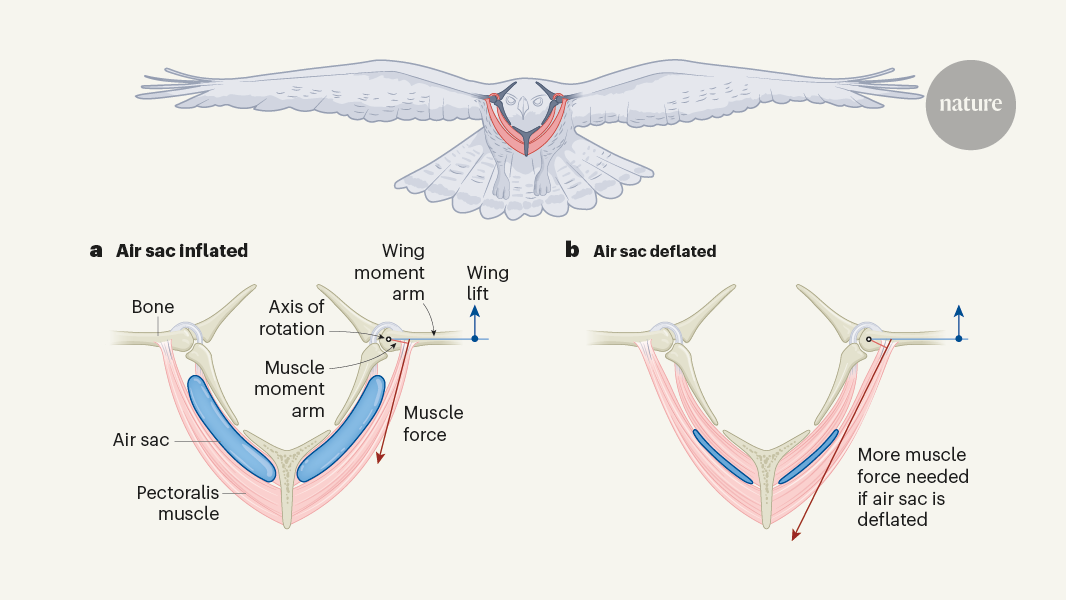Respiratory System Adaptations in Soaring Birds Reduce Energy Costs for Flight
Główne pojęcia
Adaptations in the respiratory system of soaring birds can reduce the energy required for gliding and soaring flight.
Streszczenie
The article discusses the importance of energy requirements in the biology of flying animals. The researchers, Schachner et al., have found that certain parts of the respiratory system in soaring birds have the potential to lower the energy needed by the flight muscles during gliding and soaring flight.
The key highlights and insights from the article are:
Energy requirements are a crucial factor in the biology of flying animals.
The researchers, Schachner et al., have investigated the respiratory system of soaring birds and its potential to reduce the energy costs of flight.
The findings suggest that adaptations in the respiratory system of soaring birds can help lower the energy required by the flight muscles during gliding and soaring flight.
This is an important discovery as it provides insights into the energy-efficient mechanisms employed by soaring birds to conserve energy during flight.
Air sacs reduce energy costs for soaring birds
Statystyki
No specific metrics or figures were provided in the given content.
Cytaty
No direct quotes were provided in the given content.
Kluczowe wnioski z
by Bret W. Toba... o www.nature.com 06-12-2024
https://www.nature.com/articles/d41586-024-01508-4
Głębsze pytania
How do the specific adaptations in the respiratory system of soaring birds contribute to the reduced energy costs of flight?
The specific adaptations in the respiratory system of soaring birds, such as the presence of air sacs, play a crucial role in reducing the energy costs of flight. Air sacs are thin-walled structures connected to the lungs that allow for a unidirectional flow of air through the respiratory system. This system enables a more efficient exchange of oxygen and carbon dioxide, optimizing the respiratory process. By maintaining a constant flow of oxygen-rich air, the respiratory system ensures that the flight muscles receive an adequate oxygen supply, reducing the energy required for sustained flight. Additionally, the air sacs act as a heat exchanger, helping to regulate body temperature during flight, further enhancing the energy efficiency of soaring birds.
What other physiological or anatomical features in soaring birds might also play a role in their energy-efficient flight?
In addition to the respiratory system, several other physiological and anatomical features in soaring birds contribute to their energy-efficient flight. One key feature is their large wingspan, which allows for greater lift and reduced energy expenditure during gliding and soaring. The streamlined body shape of soaring birds also minimizes air resistance, enabling them to glide more efficiently. Furthermore, specialized feathers, such as wing slots and wingtip feathers, help to improve aerodynamics and reduce drag, further enhancing the energy efficiency of flight. Additionally, soaring birds have well-developed visual and spatial orientation abilities, allowing them to efficiently navigate air currents and thermal updrafts, which also contribute to their energy-efficient flight.
How can the insights from this research on soaring birds be applied to improve the energy efficiency of human-made flying machines, such as drones or gliders?
The insights gained from research on soaring birds can be valuable in improving the energy efficiency of human-made flying machines, such as drones or gliders. By incorporating design elements inspired by the physiological and anatomical features of soaring birds, engineers can develop more efficient flying machines. For example, optimizing the aerodynamic design of drones and gliders to mimic the streamlined body shape and wing structures of soaring birds can reduce air resistance and improve overall flight efficiency. Additionally, integrating advanced airflow control systems based on the respiratory mechanisms of soaring birds can enhance the energy efficiency of propulsion systems in flying machines. By leveraging the natural adaptations of soaring birds, researchers can innovate new technologies that are not only energy-efficient but also environmentally sustainable.
0
